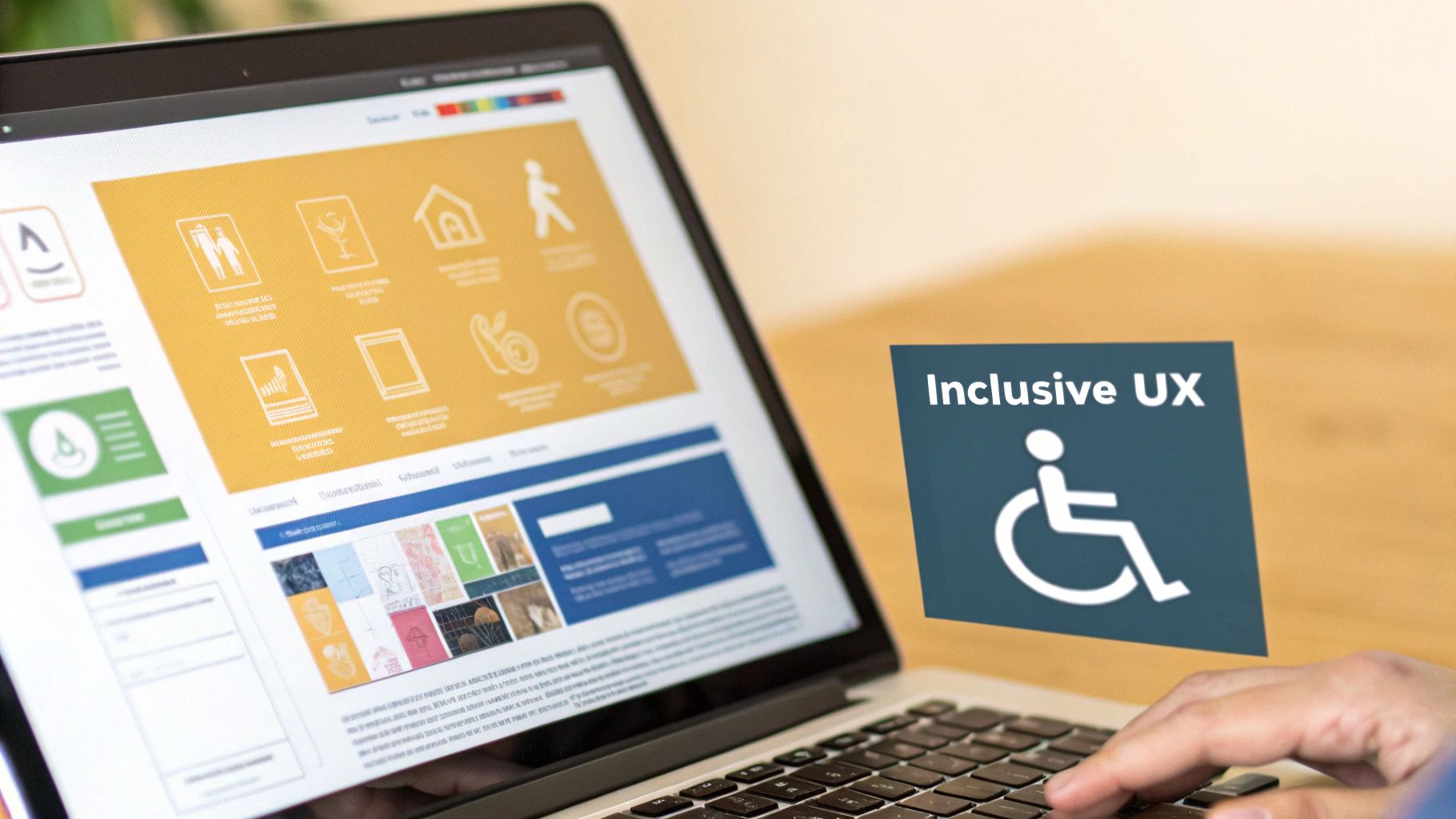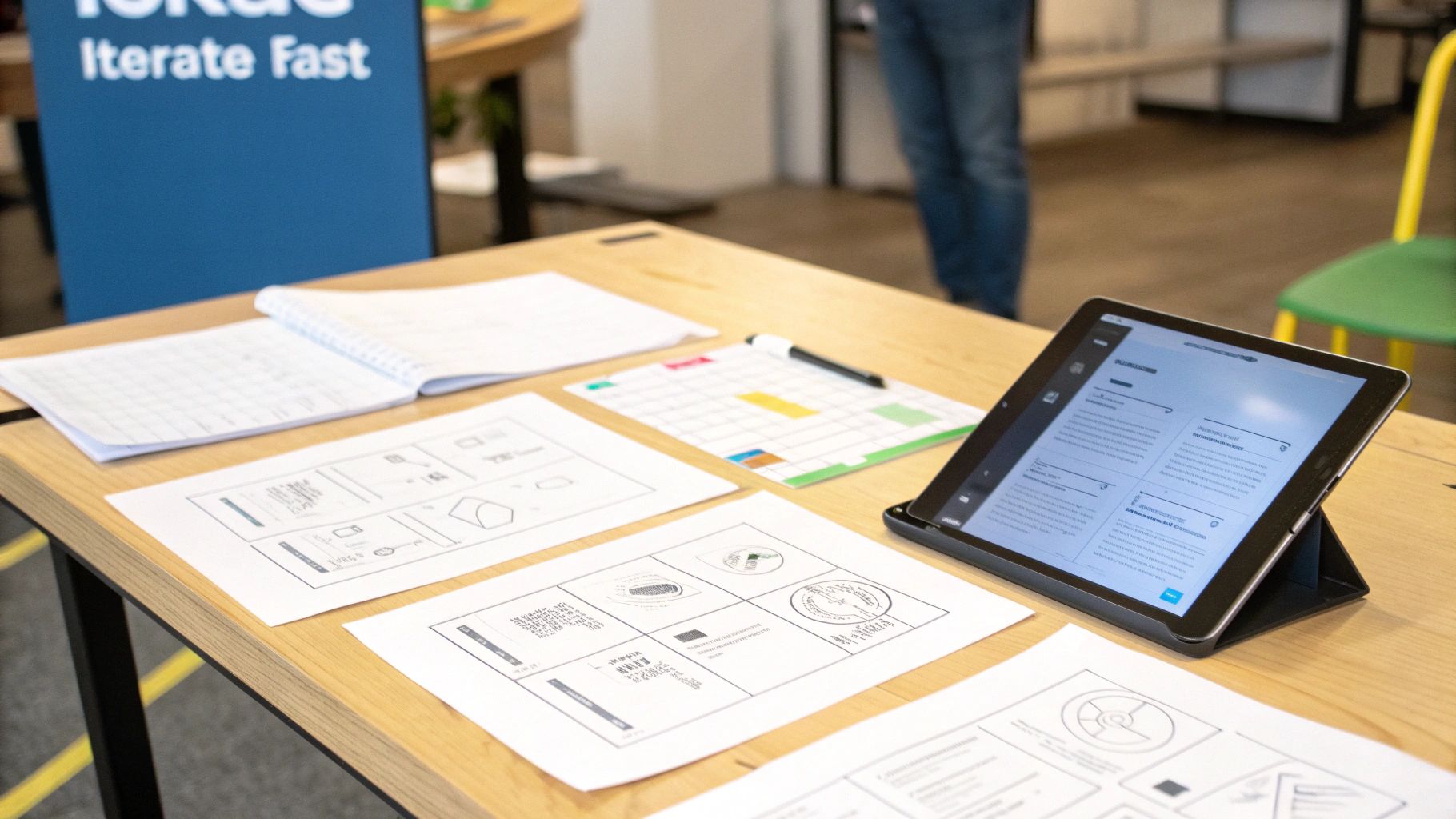In a crowded digital marketplace, a seamless user experience is the ultimate differentiator. It’s the silent ambassador for your brand, turning casual visitors into loyal customers and directly impacting your bottom line. But what separates merely functional design from truly exceptional design? The answer lies in a set of core principles that consistently prioritize the user’s needs, goals, and behaviors at every stage of development.
This guide moves beyond theory to provide a tactical roadmap. We will break down 10 essential user experience design best practices, offering actionable insights and real-world examples for each. You will learn how to implement everything from a mobile-first approach and inclusive accessibility standards to data-driven decision-making and rapid prototyping.
Whether you're an Omaha-based business building a new web application or a startup refining an existing platform, mastering these practices is fundamental to creating intuitive and effective digital products. By focusing on these core tenets, you can ensure your design decisions are not just visually appealing, but are strategically engineered to drive user engagement, boost conversions, and achieve critical business objectives. This list provides the practical foundation you need to get started.
1. User-Centered Design
User-Centered Design (UCD) is an iterative design philosophy that places the real-world user at the absolute center of every phase of the development process. Instead of building a product based on assumptions or internal preferences, UCD demands that you understand user needs, limitations, and contexts first. This approach ensures the final product is not only functional but also intuitive and genuinely helpful, making it one of the most crucial user experience design best practices to master.

The core principle is simple: design for the people who will actually use the product. Consider Airbnb's booking flow; it directly addresses traveler anxieties by highlighting host reviews, cancellation policies, and transparent pricing. This focus on user concerns builds trust and streamlines the decision-making process, leading to higher conversion rates.
How to Implement User-Centered Design
To effectively adopt this methodology, your team must commit to ongoing user engagement and feedback. To achieve truly user-centered outcomes, exploring detailed web application UX design tips for user-centered success can provide a structured roadmap for your projects.
Here are some actionable steps to get started:
- Conduct User Research: Begin with stakeholder interviews, user surveys, and competitor analysis to gather foundational insights before a single wireframe is drawn.
- Create User Personas: Synthesize your research into detailed user personas that represent your target audience segments. To dive deeper into this process, you can learn how to create detailed buyer personas for your business.
- Map User Journeys: Visualize the steps users take to accomplish a goal, identifying their pain points, motivations, and opportunities for improvement along the way.
- Prototype and Test: Build interactive prototypes and conduct usability tests with real users to validate design decisions and gather critical feedback early and often.
2. Mobile-First Design
Mobile-First Design is a strategy that flips the traditional design process on its head. Instead of designing for a large desktop screen and then trying to shrink it down for mobile, you start with the smallest screen first. This forces you to prioritize core content and functionality, ensuring a clean, focused, and high-performing experience on the devices most users carry in their pockets. As mobile traffic continues to dominate, adopting this approach has become an essential user experience design best practices for modern web and application development.

The central idea is constraint as a benefit. By focusing on the mobile user's context, which often involves limited attention and connectivity, you create a more efficient and accessible product for everyone. Consider Instagram; its interface is built entirely around mobile actions like scrolling, tapping, and swiping, making photo sharing seamless. This mobile-centric approach ensures the app is fast and intuitive, which is key to its massive user engagement.
How to Implement Mobile-First Design
Adopting a mobile-first mindset requires a disciplined approach to content hierarchy and user interaction from the very beginning of a project. It means making tough decisions early to distill the experience down to its most valuable elements before scaling up for larger screens.
Here are some actionable steps to get started:
- Prioritize Content Ruthlessly: Identify the most critical information and actions users need on a small screen. Strip away anything non-essential to reduce clutter and improve loading times.
- Design for Touch: Create larger tap targets and consider thumb-friendly navigation zones. Ensure buttons and interactive elements are easily accessible without requiring precise clicks.
- Embrace Progressive Enhancement: Start with a baseline of functionality that works on all devices, then add more advanced features and complex layouts for larger viewports with more capabilities.
- Test on Real Devices: While emulators are useful, nothing beats testing your design on actual mobile phones to understand how it performs and feels in a real-world context.
3. Consistency and Standards
Consistency in design means maintaining uniform patterns, visual elements, interactions, and terminology across a product or system. By adhering to established standards, you create a predictable and learnable environment, which reduces cognitive load for the user. This principle ensures that users don't have to relearn how your interface works in different sections, making it a foundational user experience design best practice.

This practice is powerfully demonstrated by Google's Material Design system, which creates a unified experience across products like Gmail, Google Drive, and Google Calendar. A button or icon behaves the same way everywhere, reinforcing user intuition and building trust. This cohesive approach makes complex ecosystems feel familiar and easy to navigate, dramatically improving usability.
How to Implement Consistency and Standards
Achieving consistency requires a systematic approach to design and development, grounded in clear documentation and team alignment. A well-defined system prevents design drift and ensures that as your product scales, the user experience remains coherent and intuitive.
Here are some actionable steps to get started:
- Create a Design System: Develop and maintain a comprehensive design system or style guide that documents UI components, visual styles, and interaction patterns.
- Document Key Patterns: Clearly define and document use cases for common interaction patterns to ensure they are applied uniformly across the platform.
- Conduct Regular Audits: Periodically review your product to identify and correct inconsistencies in visual design, language, and functionality.
- Train Your Team: Ensure all team members, including designers, developers, and product managers, are trained on the established design standards and guidelines.
4. Accessibility and Inclusive Design
Accessibility and Inclusive Design is the practice of creating products, services, and environments that are usable by people with the widest possible range of abilities, disabilities, and circumstances. Rather than treating accessibility as an afterthought, this approach integrates it into the core design process. By designing for users with diverse visual, auditory, motor, and cognitive needs, you create a more robust and user-friendly experience for everyone, making it an essential component of modern user experience design best practices.

This philosophy extends beyond just compliance with standards; it’s about empathy and equity. For instance, Microsoft’s Xbox Adaptive Controller was designed specifically for gamers with limited mobility but ended up benefiting anyone looking for custom control setups. Similarly, high-contrast text and clear captions, initially intended for visually or hearing-impaired users, also improve usability for people in bright sunlight or noisy environments.
How to Implement Accessibility and Inclusive Design
Adopting an inclusive mindset requires a deliberate effort to understand and remove barriers that prevent access. It means moving from designing for the "average" user to considering the full spectrum of human diversity.
Here are some actionable steps to get started:
- Provide Text Alternatives: Use descriptive alt text for all meaningful images so screen readers can convey the information to visually impaired users.
- Ensure Sufficient Color Contrast: Check that text and interactive elements have a high enough contrast ratio against their background to be legible for users with low vision.
- Use Semantic HTML: Structure content with proper headings (H1, H2, H3), lists, and other HTML5 elements to create a logical and navigable hierarchy for assistive technologies.
- Design for Keyboard Navigation: Ensure every interactive element, from links to form fields, can be accessed and operated using only a keyboard.
- Test with Real Users: Involve people with disabilities in your usability testing process to gain firsthand insights into real-world challenges and validate your design solutions.
5. Information Architecture and Navigation
Information Architecture (IA) is the art and science of organizing and labeling digital content to support usability and findability. It creates a clear structure that helps users understand their location within a product and easily find the information they need. A well-designed IA, paired with intuitive navigation, is a foundational element of positive user experience design best practices, preventing user frustration and task abandonment.
Think of Amazon's website; its robust IA allows millions of products to be categorized and filtered logically, guiding users from broad categories to specific items effortlessly. This organizational clarity makes browsing a massive inventory manageable and efficient, directly impacting a user's ability to make a purchase and their overall satisfaction with the platform.
How to Implement Information Architecture and Navigation
Effective IA is built on a deep understanding of user mental models and business goals. To ensure your structure aligns with user expectations, it's essential to research how they think about and categorize information within your domain.
Here are some actionable steps to get started:
- Conduct Card Sorting Exercises: Ask users to group topics or content into categories that make sense to them. This provides direct insight into their mental models and informs your content structure.
- Use Familiar Navigation Patterns: Stick to established patterns like top navigation bars, sidebars, or tabbed navigation. Using familiar conventions reduces the cognitive load on your users.
- Implement Effective Search: A powerful search function with filters, sorting options, and autocomplete suggestions acts as a safety net, helping users find what they need quickly when navigation isn't enough.
- Create a Clear Visual Hierarchy: Use typography, spacing, and color to visually communicate the structure of information. Headings should be distinct from subheadings and body text, guiding the user's eye through the content logically.
6. Feedback and Communication
Effective feedback and communication involve providing users with clear, timely, and understandable information about their actions and the system's status. When a user interacts with an interface, they need to know what is happening, what has happened, and what will happen next. This principle, a cornerstone of user experience design best practices, builds trust by making the system feel predictable and responsive.
This practice is about maintaining an open dialogue between the user and the interface. Think of Stripe's real-time form validation; it immediately flags an incorrect credit card number, preventing a failed transaction later. Similarly, Gmail's "Undo Send" notification provides a critical safety net, confirming an action was taken while offering a chance to reverse it. This immediate and contextual information empowers users and reduces frustration.
How to Implement Feedback and Communication
Implementing a strong feedback system requires anticipating user needs and providing reassurance at key interaction points. To understand how these micro-interactions contribute to the bigger picture, you can discover valuable strategies on how to improve customer experience and build lasting loyalty.
Here are some actionable steps to get started:
- Provide Immediate Confirmation: Use visual cues like button state changes, confirmation messages, or subtle animations to acknowledge every significant user action.
- Show System Status: For processes that take longer than a few seconds, use progress bars or loading spinners to manage expectations and show that the system is working.
- Deliver Actionable Error Messages: Instead of generic "Error" alerts, write clear, specific messages that explain what went wrong and how the user can fix it.
- Use an Appropriate Tone: Ensure all system messages, from success confirmations to error alerts, match your brand's voice and the context of the user's task.
7. Performance and Speed Optimization
Performance and Speed Optimization focuses on ensuring an interface loads quickly, responds instantly, and operates smoothly across all devices and network conditions. A slow, lagging experience frustrates users and can lead to abandonment, making speed a foundational element of user satisfaction. This discipline is one of the most impactful user experience design best practices because it directly influences user perception, engagement, and conversion rates.
The core principle is that a fast experience feels like a high-quality one. Consider Google's search results page; it loads almost instantly, reinforcing the brand's reputation for efficiency and reliability. This immediate feedback keeps users engaged and focused on their task without the friction of waiting. A fast website is often perceived as more trustworthy and professional.
How to Implement Performance and Speed Optimization
To effectively improve performance, your team must adopt a speed-first mindset, treating it as a feature, not an afterthought. Integrating these practices requires collaboration between designers and developers. You can explore a deeper dive into these technical considerations by reviewing the 9 best practices for web development that directly support a faster user experience.
Here are some actionable steps to get started:
- Optimize All Assets: Compress images using modern formats like WebP, minify CSS and JavaScript files, and remove any unused code to reduce the overall page weight.
- Implement Lazy Loading: Load images, videos, and other non-critical content only when they are about to enter the user's viewport, which significantly speeds up initial page load.
- Utilize Caching Strategies: Leverage browser and server-side caching to store frequently accessed resources, so returning visitors experience near-instant load times.
- Design for Perceived Performance: Use skeleton screens, progress bars, and other optimistic UI elements to provide immediate visual feedback while content loads in the background.
8. Content Strategy and Clarity
Content Strategy and Clarity focuses on planning, creating, and governing content that is not only useful and usable but also easy to understand. It dictates that the words on your interface, from button labels to error messages, are as integral to the user experience as the visual design. This principle ensures that all text serves a purpose, guiding users and helping them accomplish their goals, solidifying its role as one of the most impactful user experience design best practices.
The core of this practice is treating content as a key design component. Consider Mailchimp's interface copy; it uses a conversational, encouraging, and helpful tone that demystifies complex marketing tasks. This approach makes the platform less intimidating for new users and reinforces the brand's supportive personality, which directly improves user confidence and retention.
How to Implement Content Strategy and Clarity
To effectively implement this principle, you must integrate writing and content planning into the design process from the very beginning, not as an afterthought. This ensures that the language used on your platform is intentional, consistent, and user-focused.
Here are some actionable steps to get started:
- Write for Scannability: Use clear headings, bullet points, and short paragraphs to structure information. Users rarely read every word, so make key information easy to find.
- Use Plain Language: Avoid technical jargon and internal acronyms. Opt for simple, familiar words that your target audience will understand immediately.
- Provide Essential Context: When explaining complex concepts or requiring users to make important decisions, offer brief, helpful guidance and examples directly within the interface.
- Test for Comprehension: During usability testing, ask users to explain what a piece of text means to them. This will reveal if your copy is as clear as you think it is.
9. Data-Driven Design Decisions
Data-Driven Design is the practice of grounding your creative choices in solid user data rather than relying solely on intuition or internal assumptions. It involves collecting and analyzing quantitative and qualitative information to understand user behavior, validate hypotheses, and measure the impact of design changes. This approach transforms UX from a subjective art into a strategic science, making it a cornerstone of effective user experience design best practices.
The core principle is to let evidence guide your decisions, ensuring that every design iteration is a measurable step toward a better user experience. Consider how Spotify creates its "Discover Weekly" playlists; the recommendations are not random but are meticulously crafted based on your listening history, skipped songs, and liked tracks. This data-driven personalization creates a deeply engaging and valuable experience that keeps users coming back.
How to Implement Data-Driven Design Decisions
Adopting a data-driven mindset requires integrating analytics and testing into your design workflow from the very beginning. It's about asking "What does the data say?" before making significant changes.
Here are some actionable steps to get started:
- Define Clear Metrics: Before launching a new feature or design, establish Key Performance Indicators (KPIs) like conversion rate, task completion time, or user satisfaction scores to measure success.
- Combine Data Sources: Blend quantitative data (e.g., analytics, heatmaps) with qualitative insights (e.g., user interviews, surveys) to understand both what users are doing and why they are doing it.
- Conduct A/B Tests: For major design changes, run statistically significant A/B tests to compare the performance of a new design against the original. This provides concrete evidence of which version better serves user needs.
- Analyze Behavior Patterns: Regularly review user behavior analytics to identify friction points, drop-offs, and opportunities for optimization in the user journey.
10. Iterative Design and Prototyping
Iterative Design is a cyclical process of prototyping, testing, analyzing, and refining a product in repeated cycles. Rather than aiming for a perfect final product in one go, this approach embraces continuous improvement by making incremental changes based on user feedback. This methodology is one of the most effective user experience design best practices because it reduces risk by allowing teams to validate ideas early and often before committing significant development resources.
The core principle is to learn and adapt quickly. Consider how Google's Design Sprint process compresses months of work into a single week, moving from idea to a testable prototype to gather immediate user feedback. This rapid cycle prevents teams from investing heavily in features that don’t resonate with users, ensuring the final product is more closely aligned with genuine needs.
How to Implement Iterative Design and Prototyping
To effectively implement iterative design, your team must cultivate a culture of rapid experimentation and learning. To learn quickly from user feedback, consider adopting principles from the Lean Startup Methodology, which aligns perfectly with this build-measure-learn cycle.
Here are some actionable steps to get started:
- Start with Low-Fidelity Prototypes: Begin with simple sketches and wireframes to explore concepts quickly and cheaply. This allows for broad ideation without getting bogged down in visual details.
- Test Early and Often: Gather feedback from real users at every stage, from paper prototypes to high-fidelity mockups. Early testing uncovers critical usability issues before they become expensive to fix.
- Set Clear Iteration Goals: Define specific success criteria for each cycle. For example, aim to reduce the time it takes for a user to complete a key task by a measurable percentage.
- Use Collaborative Tools: Employ platforms like Figma or InVision that allow your entire team to provide feedback, view changes in real-time, and maintain a single source of truth for the design.
User Experience Design Best Practices Comparison
| Aspect | User-Centered Design | Mobile-First Design | Consistency and Standards | Accessibility and Inclusive Design | Information Architecture and Navigation | Feedback and Communication | Performance and Speed Optimization | Content Strategy and Clarity | Data-Driven Design Decisions | Iterative Design and Prototyping |
|---|---|---|---|---|---|---|---|---|---|---|
| Implementation Complexity 🔄 | High - iterative & research-heavy | Medium - focus on mobile constraints | Medium - requires planning & documentation | High - compliance and diverse needs | High - complex structure & user research | Medium - timing & placement sensitive | High - requires technical expertise | Medium - cross-team collaboration needed | High - data collection and analysis skills | Medium - resource for prototyping & feedback |
| Resource Requirements ⚡ | Significant user research and testing | Moderate - device testing & design effort | Considerable documentation & maintenance | Extensive testing & education efforts | Significant user testing & content management | Moderate - development & testing of feedback | High - continuous optimization & monitoring | Significant writing & editing resources | Tools and analysts for data collection | Tools for prototyping & frequent user testing |
| Expected Outcomes 📊 | ⭐⭐⭐⭐ Increases satisfaction & usability | ⭐⭐⭐⭐ Optimized mobile experience & SEO | ⭐⭐⭐ Reduces cognitive load & increases trust | ⭐⭐⭐⭐ Expands user base & ensures compliance | ⭐⭐⭐ Improves findability & engagement | ⭐⭐⭐ Improves trust & error recovery | ⭐⭐⭐⭐ Faster load times & better engagement | ⭐⭐⭐ Improves comprehension & brand trust | ⭐⭐⭐⭐ Data-driven improvements & validation | ⭐⭐⭐⭐ Validated designs & reduced risks |
| Ideal Use Cases 💡 | Products needing deep user insight | Mobile-centric apps & responsive websites | Large products/systems needing uniformity | Products targeting diverse abilities | Content-heavy or complex navigation sites | Interfaces where feedback reduces errors | Performance-critical sites and apps | Content-rich platforms needing clarity | Products requiring measurement & optimization | Projects emphasizing rapid validation & changes |
| Key Advantages ⭐ | Prioritizes real user problems & usability | Ensures mobile usability & faster load | Builds consistency, trust & maintainability | Inclusive, legal compliance & broader reach | Clear structure enhances discoverability | Reduces user anxiety & supports successful use | Enhances user experience with speed & stability | Builds trust with clear, actionable content | Reduces guesswork; data-backed prioritization | Encourages innovation and collaborative feedback |
Putting These Practices into Action
We’ve explored ten fundamental user experience design best practices, from establishing a user-centered foundation and prioritizing mobile-first design to embracing data-driven iteration. Each principle, whether it's ensuring WCAG-compliant accessibility or optimizing for lightning-fast performance, serves a single, unified goal: to create digital products that are not just usable, but truly valuable and enjoyable for your audience.
Implementing these concepts transforms your design process from a series of subjective decisions into a structured, evidence-based discipline. It shifts the focus from "what we think users want" to "what we know users need," a crucial distinction for any Omaha-based business or e-commerce retailer aiming for sustainable growth. Mastering these practices is the difference between a website that simply exists and a web application that actively drives engagement, conversions, and customer loyalty.
Your Actionable Path Forward
The journey to exceptional UX is continuous. It’s not about checking off a list one time; it’s about embedding these principles into your team’s culture and daily workflow. To start making an immediate impact, consider these next steps:
- Conduct a UX Audit: Begin by evaluating your existing digital product against the ten practices discussed. Identify 2-3 high-impact areas for improvement, such as simplifying your navigation or improving mobile load times.
- Prioritize User Feedback: If you aren’t already, implement a system for consistently gathering and analyzing user feedback. This could be as simple as adding a feedback form or as robust as conducting regular usability testing sessions.
- Develop a Unified Strategy: A successful implementation requires a clear roadmap. To effectively implement these practices and develop a cohesive plan, consider exploring a comprehensive guide on the best user experience design strategy to help align your team's efforts.
Ultimately, a commitment to these user experience design best practices is a commitment to your customers. It demonstrates respect for their time, an understanding of their needs, and a dedication to solving their problems. By building this foundation of empathy and efficiency, you create more than just a functional interface; you build a strong, lasting relationship between your brand and the people it serves.
Ready to transform your digital strategy with an expert partner? At Up North Media, we build conversion-optimized web applications and execute data-driven marketing strategies grounded in these core UX principles. Contact us to learn how we can help your organization accelerate growth and achieve measurable results.
